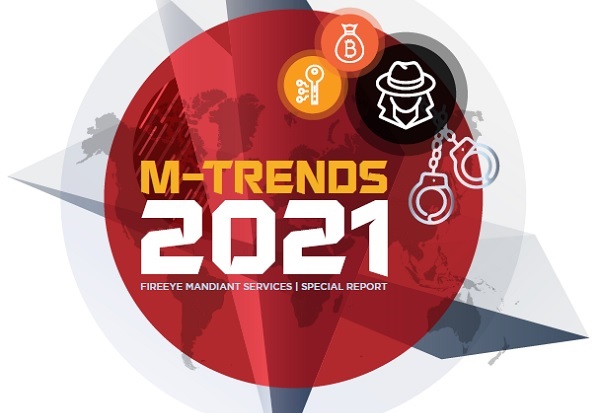REPORTS
M-Trends 2021
Expanding Knowledge by Sharing Intrusion Realities
Security practitioners faced a series of challenges in this past year which forced organizations into uncharted waters. As ransomware operators were attacking state and municipal networks alongside hospitals and schools, a global pandemic response to COVID-19 necessitated a move to remote work for a significant portion of the economy. Organizations had to adopt new technologies and quickly scale outside of their normal growth plans.
As organizations settled into a new understanding of “normal,” UNC2452, a suspected nation-state threat actor, conducted one of the most advanced cyber espionage campaigns in recent history. Many security teams were forced to suspend wide-ranging analyses around the adoption of remote work policies and instead focus on a supply chain attack from a trusted platform Nation states taking a cyber espionage approach to COVID research, threat groups working together to achieve their objectives, exploitation of quickly adopted workfrom-home strategies and a wake-up call for global supply chain compromise – experiences in 2020 will shape security policies for years to come.
Themes covered in M-Trends 2021 include: :
- 59% of the security incidents investigated by Mandiant last year were initially detected by the organizations themselves, an improvement of 12% from the prior year.
- Ransomware has evolved into multifaceted extortion where actors not only deploy ransomware encryptors across victim environments, but also employ a variety of other extortion tactics to coerce victims into complying with demands.
- FIN11, a recently named financially motivated threat group, was responsible for widespread phishing campaigns, that conducted several multifaceted extortion operations.
- Pervasive ransomware campaigns drove down the median dwell time as threat actors sought to capitalize on shifting trends in the workspace and a global crisis.
- UNC2452, a suspected state-sponsored group, undertook a broad-scale espionage campaign after injecting a trojanized DLL into the SolarWinds Orion build process. Mandiant identified the campaign and worked with law enforcement agencies and industry partners to protect organizations and respond to the adversary.
- Mandiant experts observed the use of 63% of MITRE ATT&CK techniques, and just over a third of techniques observed were seen in more than 5% of intrusions.
- Threat actors took advantage of infrastructure supporting work-at-home with an increased focus on vulnerability exploitation.
One of the most striking trends for the period of October 1st, 2019 to September 30th, 2020 was the significant reduction in the global median dwell time. At 24 days, this is the first time Mandiant has observed the global median dwell time dip below one month. While this reduction in dwell time may correlate to better visibility and response, it is also likely the preponderance of ransomware helped drive down the time between initial infection and identification.
With the inclusion of all the observations listed above, the addition of new metrics reported in By The Numbers, the introduction of the named threat group FIN11, new case studies, and many other topics, M-Trends 2021 builds on our transparency to continue providing critical knowledge to those tasked with defending organizations. The information in this report has been sanitized to protect identities of victims and their data.
SHARE:

About the Provider






